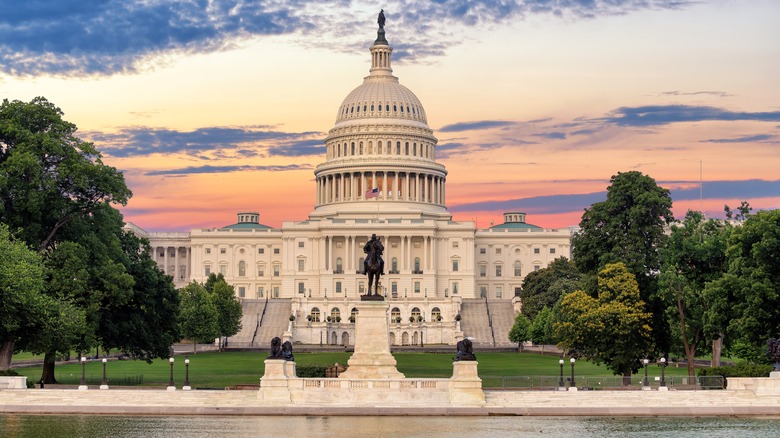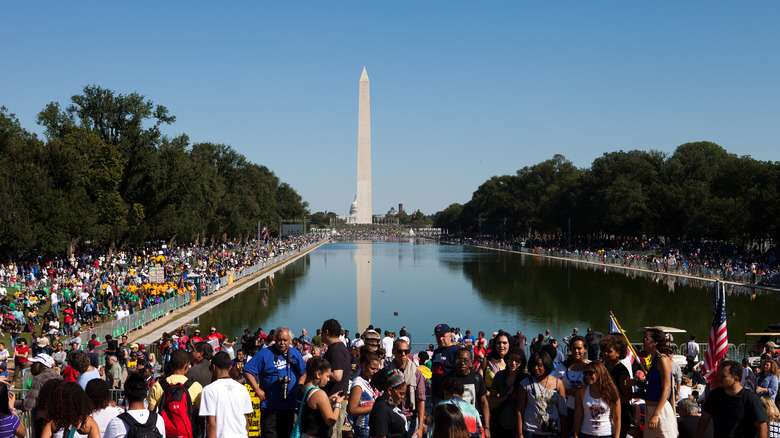This Typical D.C. Experience Could Make Your Trip To America's Capital More Complicated Than You Expect
It's not unusual to encounter a protest in the nation's capital. Residents and visitors alike regularly exercise their First Amendment right to freedom of speech and peaceful assembly, and these demonstrations take place year-round in Washington, D.C. For tourists, this can throw a wrench in their travel plans. If you're trying to avoid protests on your D.C. trip, it's not enough to just avoid the Capitol, the White House, and the Supreme Court. Daily encampments outside major media headquarters like NCB, Fox, and MSNBC — all of whom are headquartered in D.C. — have been demanding fair coverage of Gaza, and protests in front of the headquarters of Immigration and Customs Enforcement draw crowds near the International Spy Museum, a popular tourist attraction. Anti-abortion protests are common outside Planned Parenthood in NoMa, a popular neighborhood in DC, and various embassies, especially the Embassy of Israel in Forest Hills and the Embassy of Russia in Glover Park. The Lincoln Memorial is also a hot spot for demonstrations. For instance, the Stand Up for Science rally in May attracted several thousand participants to the foot of this historic landmark.
Seemingly every day, there's a demonstration somewhere in D.C. Most are small in attendance numbers, but multiple big ones have taken place in the first half of 2025: the People's March in January with around 50,000 attendees, or the Hands Off protest in April with 100,000. Events and gatherings that aren't protests are also a thing in this city, like World Pride, which drew tens of thousands of attendees in June, or Donald Trump's inauguration in January, for which he used 25,000 law enforcement officers and fenced 30 miles around the Capitol, the longest fence ever erected in the city.
How can protests affect your trip to DC?
The vast majority of protests remain peaceful, but their frequency and scale can reshape how residents and tourists move through the city. If you're planning a trip to D.C., check local news and event calendars before setting out each day to avoid areas where major protests are scheduled, Organize D.C. shares weekly lists with all the scheduled ones. Keep in mind that if there's an event in the city, you're likely to experience sudden changes to itineraries, like museums adjusting hours or tours being rerouted, so have some backup activities in mind just in case. Also, situational awareness is key: While protests are generally nonviolent, large crowds can make it uncomfortable for those simply trying to sightsee and could even be a golden opportunity for pickpockets in a city with high crime rates. Even if a protest is nonviolent, though, be aware that sometimes police have tear-gassed protesters.
What about closed roads? The metro will be your savior. What happens in the streets above the ground doesn't typically affect the underground. Traffic and rerouting won't be an issue there, though before and after a protest, public transportation can become crowded, especially if demonstrations coincide with peak commuting hours — it's no surprise that Washington, D.C. is the city with the worst traffic in the U.S. Still, subway trains run frequently during the day. If you plan to get to D.C. a day or two after a protest, you might see fences still erected and some roads closed. For instance, after the U.S. Army's 250th anniversary parade, some roads stayed closed for up to four days, so make sure to plan accordingly, and try these simple and fun ways to avoid Washington's crowds during your visit.

